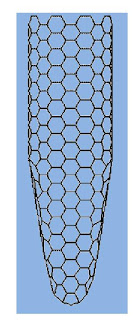Dispersive micro-solid phase extraction with oxidized carbon nanohorns

Figure 1. Structure of SWCHs Carbon allotropes have been extensively used as sorbents in solid phase extraction (SPE) and solid phase microextraction (SPME). Graphitized and activated carbons, fullerenes, carbon nanotubes, diamond and graphene can be highlighted among this class of materials. Today we focus our attention on the potential of carbon nanohorns as sorbent in SPE. Single walled carbon nanohorns (SWCNHs), which were discovered by Ijima in 1999, are single wall graphitic structures formed out of a single graphene sheet rolled up to form conical (horn-like) shapes which are rounded at the tip (1). These nanoparticles, schematically presented in Figure 1, tend to aggregate producing dahlia-like structures with sizes in the range from 80-100 nm. Thanks to their high superficial area and their ability to interact with different analytes, SWCNHs can be considered as promising nanomaterials in extraction procedures (2). Moreover, the weak interaction between individual SW